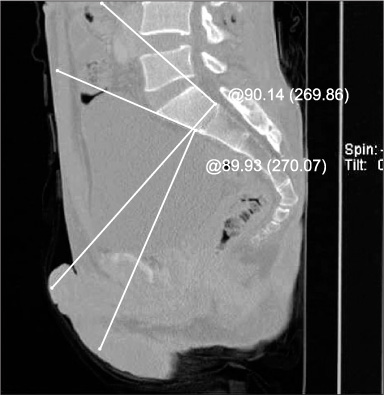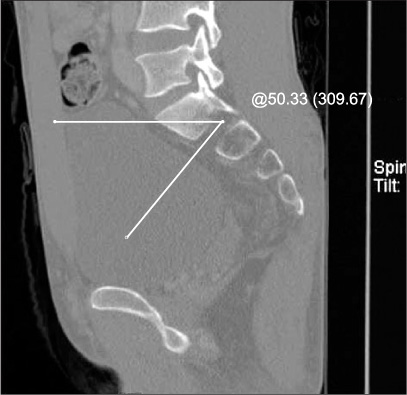J Korean Orthop Assoc.
2012 Feb;47(1):9-14. 10.4055/jkoa.2012.47.1.9.
Optimal Pelvic Inlet and Outlet Radiograph Angles in Korean Patients
- Affiliations
-
- 1Department of Orthopedic Surgery, Ajou University Hospital, Ajou University School of Medicine, Suwon, Korea. thrtkr@ajou.ac.kr
- KMID: 1439986
- DOI: http://doi.org/10.4055/jkoa.2012.47.1.9
Abstract
- PURPOSE
Until now, pelvic injuries have been evaluated with 45degrees inlet and 45degrees outlet radiographs. Following these customary guidelines may not produce the best plane to evaluate pelvic injury due to variability of pelvic anatomy. Recent data based on the American population suggested 25degrees and 60degrees as the optimal angle for each inlet and outlet views, respectively. We hypothesized that inlet and outlet radiographic views to examine the clinically relevant landmarks vary from routine 45degrees inlet and outlet views and aimed to find optimal angles for Korean patients.
MATERIALS AND METHODS
One hundred consecutive patients, aged between 30 to 60 years (50 male and 50 female patients), without pelvic ring disruption or fractures who had undergone routine axial pelvic computed tomography scans were retrospectively identified. The optimal inlet and outlet angles required to profile the clinically relevant pelvic anatomy were quantified for each patient.
RESULTS
The optimal inlet angle to profile the anterior body of S1 and S2 required an average caudal tilt of 24.2degrees and 27.9degrees, respectively. The average outlet angle perpendicular to the body of S1 was 54.8degrees and perpendicular to S2 was 52.3degrees. The optimal angles were the same for male and female patients and were independent of patient age.
CONCLUSION
Screening inlet and screening outlet radiographs made at 25degrees and 55degrees, respectively, are recommended for viewing clinically relevant osseous pelvic anatomy in Koreans.
Keyword
Figure
Reference
-
1. Chapman MW. Chapman's orthopaedic surgery. 2001. 3rd ed. Philadelphia: Lippincott Williams and Wilkins;531–535.2. Bucholz RW, Heckman JD, Court-Brown CM. Rockwood and Green's fracture in adults. 2006. 6th ed. Philadelphia: Lippincott Williams and Wilkins;1602–1603.3. Pennal GF, Tile M, Waddell JP, Garside H. Pelvic disruption: assessment and classification. Clin Orthop Relat Res. 1980. (151):12–21.
Article4. Mostafavi HR, Tornetta P 3rd. Radiologic evaluation of the pelvis. Clin Orthop Relat Res. 1996. (329):6–14.
Article5. Mears DC, Durbhakula SM. Chapman MW, editor. Fractures and dislocations of the pelvic ring. Chapman's orthopaedic surgery. 2001. vol. 1:3rd ed. Philadelphia: Lippincott Williams and Wilkins;531–585.6. Browner BD, Jupiter JB, Levine AM, Trafton PG. Skeletal trauma: fractures, dislocations, ligamentous injuries. 1998. 2nd ed. Philadelphia: WB Saunders;1561–1565.7. Ricci WM, Mamczak C, Tynan M, Streubel P, Gardner M. Pelvic inlet and outlet radiographs redefined. J Bone Joint Surg Am. 2010. 92:1947–1953.
Article8. Tile M, Rubenstein J. Tile M, Helfet DL, Kellam JF, editors. Defining the injury: assessment of pelvic fractures. Fractures of the pelvis and acetabulum. 2003. 3rd ed. Philadelphia: Lippincott Williams and Wilkins;101–115.9. Pennal GF, Sutherland GO. Fractures of the pelvis (motion picture). 1961. Park Ridge, IL: American Academy of Orthopaedic Surgeons Film Library.10. Kim WJ, Lee SH, Min SH, Choi BK, Lee ES, Shin SW. Radiologic measurement of pelvic sagittal incidence and lordosis in young Korean women. J Korean Orthop Assoc. 2005. 40:14–18.
Article11. Handa VL, Lockhart ME, Fielding JR, et al. Pelvic Floor Disorders Network. Racial differences in pelvic anatomy by magnetic resonance imaging. Obstet Gynecol. 2008. 111:914–920.
Article
- Full Text Links
- Actions
-
Cited
- CITED
-
- Close
- Share
- Similar articles
-
- Changes of Endotoxin Concentration in Dialysis Solution During Hemodialysis
- Age-related trends of lesser pelvic architecture in females and males: a computed tomography pelvimetry study
- Influence of Parent Artery Segmentation and Boundary Conditions on Hemodynamic Characteristics of Intracranial Aneurysms
- Transpositions and malpositions of the great arteries
- Right Ventricular Remodeling Determines Tricuspid Valve Geometry and the Severity of Functional Tricuspid Regurgitation: A Real-Time 3-Dimensional Echocardiography Study





